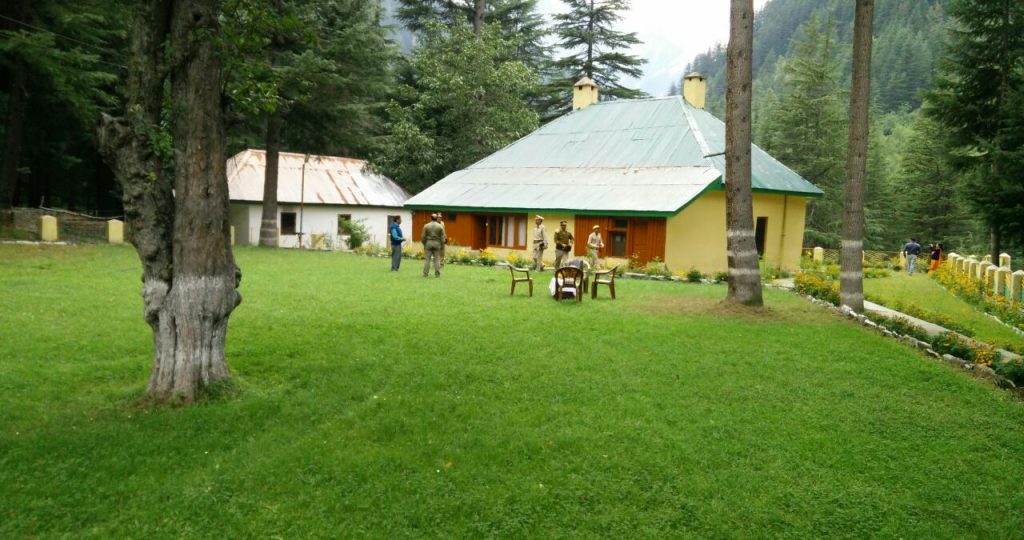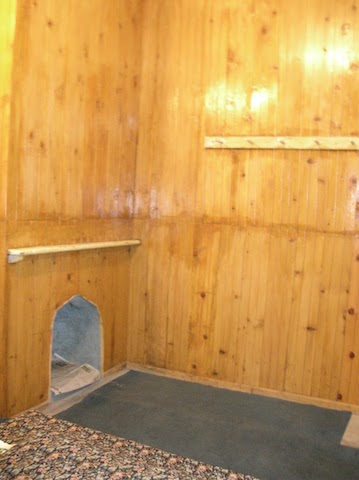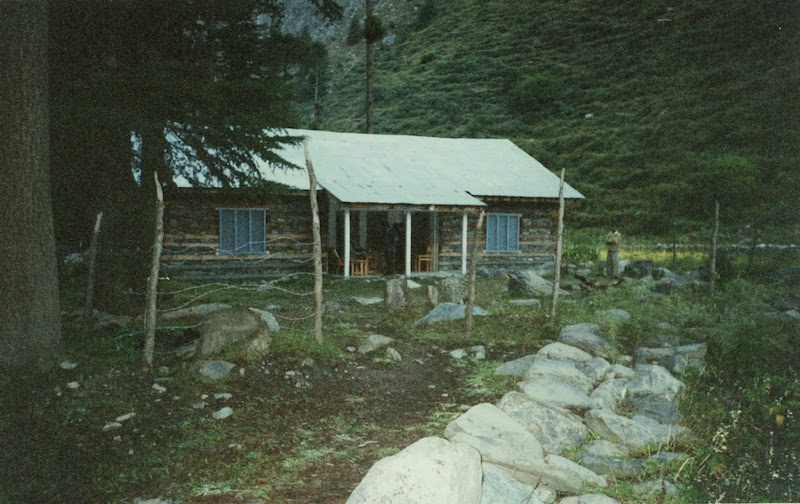Like all buildings that have hoary pasts, Rest Houses too have all kinds of stories attached to them and this gives them a mystique and distinct identity, perhaps a tourism value too if properly marketed. Take for instance the Forest Rest House (FRH) at Purthi in remote Pangi district. It was constructed in pre-Independence days by a British Range Officer called Todd. Situated above the Chandrabhaga river in a thick wooded grove, it is part of the Range office complex. Made completely of wood, which was the only material available in those days (and in abundance), it is a pleasant sight, with flat, green lawns laid out all around it, interspersed with pathways. The Forest Department has renovated and furnished it on the inside in a glitzy, Baba Ram Rahim kind of fashion but fortunately the exterior has not been altered. It used to be the RO’s residence and is therefore known as Todd’s Bungalow. Later, it was converted into an FRH.
Todd appears to have been quite a beaver at building things, because he also built the Forest complex at Killar (the district headquarters). To relax from his strenuous activities he was fond of taking walks with his dog on a narrow trail above the river. On one such amble the dog (who was on a leash) was apparently startled by something in the undergrowth and darted back, wrapping the leash around his owner’s legs and unbalancing him. Both Todd and the dog fell into the Chandrabhaga and drowned. But Todd Sahib never left his beloved bungalow, it appears. People who have spent nights in the FRH swear that he visits his house at night – he is reported to come down the chimney and fireplace of one of the bedrooms. There have been too many reports of such “sightings” to dismiss them out of hand. The whole apparition is rarely seen; what people usually sight are two sturdy legs in the fireplace, which is enough to give them such a fright that they don’t hang around to see the rest of the torso. The spectre has never harmed anyone, or created any ruckus, or thrown things around like a poltergeist: apparently it is content to walk around the building that was once its own.
Todd continues to live on through his bungalow, and adds another legend to the rich folk-lore of these mountains. I’ve spent a couple of hours in the rest house but could never spend a night there, regrettably, because of tight schedules. But I can appreciate why Todd keeps such a tight vigil on his beloved bungalow, given that the original wooden flooring has already been replaced by mustard coloured vinyl, and at any moment the govt. might decide to replace the quaint, old fireplaces with four rod heaters !


Forest Rest Houses are a god send for the committed forest officer, most of whose work lies in isolated and inaccessible areas, far from any habitation. After a day spent tramping up and down valleys and mountains, marking trees and counting stumps, it is a relief to be able to betake oneself of an evening to a place that has a roof, beds, bathrooms and a kitchen, no matter how elementary – even a 7-Star hotel cannot provide a fraction of the bliss that an FRH can at the end of a gruelling day, as I’ve discovered for myself many a time ! A typical example is the FRH at Bara Bangal.
Bara Bangal is the only remaining land-locked valley in the state (though a mule road is now coming in from the Chamba side). To access it from Billing (the present road head and world famous para-gliding site) one has to undertake an arduous, sometimes dangerous, four day trek over the 17500 feet Thamsar pass and its permanent ice fields. If ever a village needed an FRH it was Bara Bangal, but it didn’t get one till the early years of the first decade of this century. The delay is easily explained – no officer above a Deputy Ranger (or equivalent rank in other departments) ever goes there! Actually, the govt. has a monumental dilemma here, caught between a rock and a hard place, or (to be more accurate) between a mountain and a river. In an area of 1200 sq. kms there are only a dozen or so govt. employees! No one ever goes to check whether they are working, or are even present. The employees are quite fearless, confident in the (correct) belief that they are already stuck in the most difficult posting in the state and hence have nothing to fear: the govt. can do nothing worse to them ! The village has a primary and a middle school with five teachers. As expected, they usually come to take their salaries and then disappear ! I made a surprise visit there, my second, in 2005 or thereabouts and found that all seven had decamped to Baijnath! They were all suspended, of course, and even their subsistence allowance was made conditional on their collecting it in Bara Bangal. However, coming back to rest houses: Sometime around 2002-2003 the local Forest Guard, displaying the initiative of a Head of Department, decided to take matters in his own hand, secured some funds and approvals with great difficulty, and built the FRH himself !

As you can see for yourself its a very basic structure, but its better than the Hyatt for someone who has been walking and climbing for 70 kilometers, spending four nights in the open with some smelly sheep to keep him warm (if he’s lucky!), fallen into innumerable ditches and crannies, frozen his posterior every time nature issued a summons, and living off dal-roti and siddu. Its actually quite large from the inside – two rooms, a dining area, an out house for ablutions (with running water from a nearby stream conveyed by open PVC pipes!) and a kitchen. There was no electricity then (there is now, from a small micro-hydel project in a nearby nullah) and the villagers burnt the roots of pine trees called “jagni” for lighting. The hut is situated bang in the middle of the thickest stand of deodar you’ll see anywhere, on a protruding plateau above the Ravi river. And just remember – the whole thing was conceived, designed and constructed by a Forest Guard, with no help from anyone! Generations of trekkers will forever be indebted to this enterprising and far-sighted official, God bless him !
My group spent an enchanting two days in this FRH, recouping our energy and washing off the accumulated dirt, before moving on to the even more dangerous trek to Nayagram in Chamba. My greatest satisfaction ? – that we were the FIRST visitors to this FRH: our names are there on the very first page of the rest house register, the Abu Ben Adams of Bara Bangal! Go check it out !
| The author retired from the IAS in December 2010. A keen environmentalist and trekker he has published a book on high altitude trekking in the Himachal Himalayas: THE TRAILS LESS TRAVELLED.
His second book- SPECTRE OF CHOOR DHAR is a collection of short stories based in Himachal and was published in July 2019. His third book was released in August 2020: POLYTICKS, DEMOCKRAZY AND MUMBO JUMBO is a compilation of satirical and humorous articles on the state of our nation. His fourth book was published on 6th July 2021. Titled INDIA: THE WASTED YEARS , the book is a chronicle of missed opportunities in the last nine years. Shukla’s fifth book – THE DEPUTY COMMISSIONER’S DOG AND OTHER COLLEAGUES- was released on 12th September 2023. It portrays the lighter side of life in the IAS and in Himachal. He writes for various publications and websites on the environment, governance and social issues. He divides his time between Delhi and his cottage in a small village above Shimla. He blogs at http://avayshukla.blogspot.in/ |




Heart warming read. The trail where from Todd a d Dog fell down must be on its left bank? The tiny trail running all along the river from Udaipur to killar.
Btw, why bara bangal and not bhangal? Auto correct or deliberate?
As far as I know, the trail is on the right bank on which the FRH is located. As regards ” Bangal” or ” bhangal” , you’re right- the correct spelling is ” Bhangal”- sorry for the repeated typos- in fact , in my book THE TRAILS LESS TRAVELLED I have spelt it as Bhangal.
The old goat track into Pangi from Udaipur starts on the right bank and crosses to the left bank beyond Madgran and again crosses to the right bank at some point, but the motor road made later is on the right bank throughout. The Purthi rest house is on the right bank of the Chenab if i remember correctly.
From Sach onwards right into J&K for a good 60 -70 km or so, the forests on the left bank are a sight to behold; untouched wilderness. I did try to have an inter-state wildlife sanctuary declared here, but the proposal got lost in our fabled bureaucratese.
Nice to read this. I have not visited this rest house though I have been to Pangi. There is a PWD rest house at Ghiri on Dhanoutoo Jaidevi Karsog road there also it is said a man visit the rest house in night .I do not know much but such stories r there at many places .
Yes Sir, it is great to see your signatures in the Forest Rest House register when you visit it again. I stayed in Todd’s Rest House on 15th August 1984 after attending Independence Day celebrations in Killar. Roasted apples from the Todd’s fire place along with local liqueur were extremely tasty and refreshing after the AN walk from Killar to Purthy. Two French trekkers staying in next room also joined to see Todd’s dangling legs. The Chawkidar suggested that to see Todd’s legs, we would have come to this Rest House without prior briefing.
I was touring Pangi Valley as a probationer of Indian Forest Service. I started trekking from Tarela to Satrundi, Saach Pass to Killar where I stayed in the Range Officer’s residence which was built by the British Range Officer E. Sparling in 1869. Originally, it had more than 15 rooms, the big ones now converted into PWD store house. From Killar to Purthy, the trek was on right side of Chandrabhaga. However, a little ahead of Purthy, I crossed a Betula bridge (about 150 feet span) at Saur to the left side of river. This was simply wonderful. My subsequent tours to this place have been in a vehicle which certainly were not so exciting.
I spent four nights during 1990-1992 at Purthi Rest House all by myself as nobody was willing to stay in the adjoining suite. The attendant who had accompanied me from Killar also took shelter in the nearby Range Office Complex because of Todd’s visits. There was no electricity during those days.The Range Officer had advised me not to stay in the rest house and offered to make arrangements in the nearby Range Office. I politely declined but couldn’t help looking at the fire place for emergence of Todd’s legs. After the lamp blew out it was eerie and creepy. The doors and windows opened with a creaky noise. Any loud screams would have been drowned in the gushing noise of the Chenab. I slept peacefully but was reminded of all the creepy stories. The Range Officer was worried and enquired about me in the morning when I woke up from a restful sleep after trekking 26 kms from Killar.